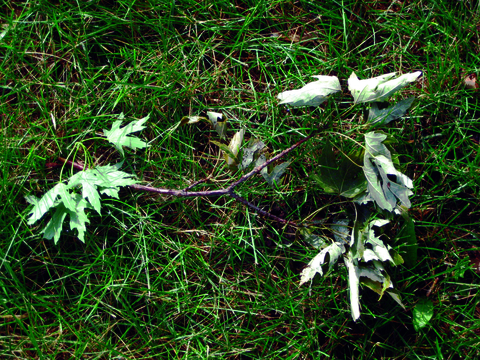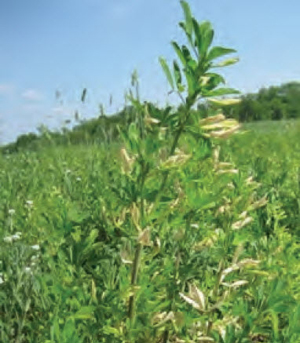Quick facts
- Be able to identify wilted leaves, such as maple and prunus species, that may harm your horse.
- To prevent the risk of colic and founder, keep horses off of pastures for at least a week after a killing frost.
- Sorghum-sudangrass can cause cyanide poisoning in horses after a fall frost, especially nonkilling frosts.
- Don’t feed horses hay that contains more than 2 percent nitrate.
- If buying sorghum-sudangrass during a drought year, test the forage for cyanide and nitrate content before feeding it.
Stress can cause changes in a plant that may put your horse’s health at risk after ingestion. Frost and drought are two common plant stressors to be aware of in Minnesota. Prevent related health issues in your horse by understanding when certain plants can be a problem.
Grazing horses after a frost
Some deciduous leaves can be deadly to horses after wilting due to:
- Broken branches
- Fall leaf shed
- Storm damage
The leaves of greatest concern to horses are wilted maple and prunus species such as chokecherry, ornamental almond and cherry trees.
Identify all seasonally toxic trees on your property. Make sure to keep your horses away from their fallen or frost-damaged leaves for at least 30 days. Horses don’t commonly eat these but may eat them by accident, especially if they are bored or hungry.
Increased colic and founder risk
Frost-damaged forages can contain a higher sugar content. This can lead to a higher risk of colic or founder for grazing horses. To help prevent these health issues, wait up to a week before turning horses back onto a pasture after a killing frost.
During the day, plants carry out the process of photosynthesis when they make sugars as an energy source. A second process, respiration, is when the plants use up the sugar they produce for energy.
Plant respiration slows down when temperatures decline to near freezing. As a result, the plants hold their sugar overnight. Freezing can stop respiration and lock the sugar in the plant for over a week. Thus, plants tend to contain more sugar in colder temperatures or after a frost.
Nutritional value of forage
As plants mature in the fall, they lose their overall nutritional value. However, the cooler temperatures and shorter days slow the rate of maturity compared to summer.
During fall, grasses gradually accumulate sugars above ground, especially in the lower stems and leaf bases of the plant. Sugar builds up gradually and is usually higher in more mature forage. Often, horses begin to prefer grasses after a frost due to the higher sugar levels. We recommend waiting up to a week before grazing horses after a killing frost.
After a hard, killing frost, the quality of legumes (e.g. alfalfa) and grasses starts to decline. The quality of legumes declines faster than grass quality because legumes lose their leaves. Leaves affect the overall quality of grasses and legumes.
Forage protein, equine total digestible nutrients and equine digestible energy decrease gradually after a hard frost. This decline is due to the forage plants leaching nutrients and continued plant respiration.
Overall, grass species tend to retain their nutritional value longer after a killing frost compared to legumes.
Sorghum-sudangrass
Sorghum-sudangrass can cause cyanide poisoning in horses after a fall frost, especially nonkilling frosts. Less mature sorghum-sudangrass tends to contain higher amounts of cyanide. Don’t allow horses to graze new growth after a frost. The plant’s leaves contain more cyanide than the stems. Keep horses off pastures containing frost-damaged sorghum-sudangrass.
Cyanide poisoning signs include:
- Drooling
- Rapid breathing
- Convulsions
- Staggering
- Death
Johnsongrass can also cause cyanide poisoning after a frost.
Nitrate poisoning
Nitrate toxicity can result after a frost with some plants that build up nitrates. Generally, this is only a concern with some grass species where high nitrogen was used and with some weeds such as lambsquarter and pigweed.
Wait up to a week after a killing frost before grazing areas where nitrate toxicity is a concern.
Drought concerns
Most forages normally have between 100 (0.1 percent) to 1,000 (1 percent) parts per million of nitrates. Researchers fed hay that contained 1.5 to 2 percent nitrates to pregnant and nonpregnant mares. These mares produced normal foals even though their blood had higher than normal nitrate levels.
As a general rule, don’t feed horses hay that contains more than 2 percent nitrate. Levels higher than this haven’t been researched in horses. See plants that accumulate nitrate for additional information on nitrate.
Sorghum-sudangrass
Sorghum-sudangrass has good yield potential, especially in dry years. You can use it as a pasture or hay but it’s most commonly used during periods of high temperatures and drought. Sorghum-sudan grass isn’t a common horse feed, but you can feed it during droughts, especially when other forage is limited.
If buying sorghum-sudangrass during a drought year, test the forage for cyanide and nitrate content before feeding it. Don’t feed forage positive for cyanide. These compounds can harm your horse’s health.
Harmful weeds and grasses
During periods of drought, horse pasture forages may become sparse. Overgrazing and poor forage yields may cause horses to eat plants they normally wouldn’t. Horses may graze harmful, undesirable weeds simply because that’s what’s available.
Avoid overgrazing or grazing horses during periods of sparse forage. Provide supplemental hay to allow the pasture to rest and give your horse an alternative to eating potentially harmful weeds.
The following grasses have been implicated in cases of cystitis (urinary bladder inflammation) and abortion.
- Sorghum
- Sundangrass
- Sorghum-sudan hybrids
- Johnsongrass
Mares affected by cystitis may also accumulate a yellowish, sticky, granular fluid in the bladder. Death may also result from kidney damage. These grasses may also develop toxic levels of cyanide, also called prussic acid, under drought conditions.
Reviewed in 2024



